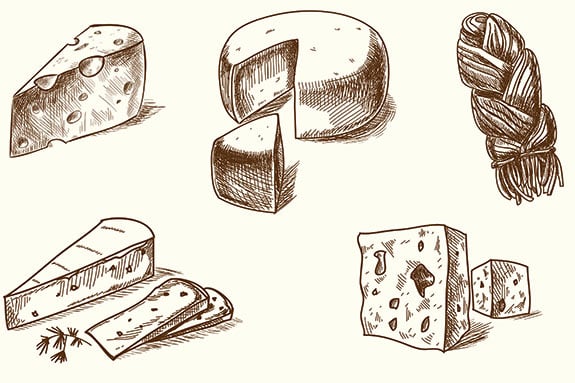Cheese

Unless you’re lactose-intolerant, the chances are that you like cheese. And when better to enjoy it than during a week when we celebrate National Cheese Day? Nobody can agree on when, how, or why this great excuse for indulging in Cheddar, Swiss, and Gouda came about, but the farmers of America’s Dairyland, our neighbors to the north in Wisconsin, are probably not complaining.
Cheese, along with eggs, is one of the world’s oldest foods – it can be traced back more than 4,000 years, and its origins (like that of so many other ancient foods) are murky. According to the International Dairy Foods Association, the creation of cheese may have come about entirely by accident, caused by “an Arabian merchant who put his supply of milk into a pouch made from a sheep's stomach, as he set out on a day's journey across the desert. The rennet in the lining of the pouch, combined with the heat of the sun, caused the milk to separate into curd and whey. That night he found that the whey satisfied his thirst, and the cheese (curd) had a delightful flavor which satisfied his hunger.”
We can relate. Here, from a variety of sources with a dog in this hunt, are some fun facts about cheese in America:
- America’s first cheese factory was opened in 1851 – not in Wisconsin, but in Rome, New York. A dairy farmer named Jesse Williams came up with the idea (decades before Henry Ford) of using an assembly-line process to make his cheeses, using milk from neighboring farms.
- The first Wisconsin cheese factory came along 17 years later, and produced that most “fragrant” of all cheeses – Limburger. Brick and Colby cheeses were also invented in Wisconsin.
- The U.S.D.A. reports that Americans consumed about 35 pounds of cheese per capita in 2015. Or, about a ton per person per lifetime, if you like that statistic better. Either way, it’s a lot!
- Cheddar is the most popular variety of cheese in the U.S. Or mozzarella, depending upon which source you believe. We’re guessing that the mozzarella consumption stat is upped considerably by its use on pizza. Speaking of that…
- Americans consume about 350 pounds of pizza every second. Yes, every second.
- One pound of cheese is composed of 10 pounds of milk, and about a third of all milk produced in the U.S. is used to make cheese. Also, approximately 90% of Wisconsin’s milk is made into cheese, and 90% of that cheese is sold outside of the state.
- Approximately 300 kinds of cheese are sold in America.
- Common sense advice: unless the cheese’s rind is waxed like Edam or Gouda, it’s edible. But if you don’t like cheese rind, feel free to cut it off. Nobody will mind.
- Finally, some great news: According to the Colgate Company (yes, the toothpaste people), cheese can help prevent tooth decay, because its presence in your mouth results in “increased PH levels.” As if you needed another excuse to eat cheese, it will please your dentist.

So, what is American cheese? Well, technically, the law dictates that it’s “processed cheese,” or “cheese food,” because it is made from at least two different varieties of cheeses. Sometimes in your grocery’s deli case, you’ll see its packages labeled “American singles” or “American slices.” It’s especially good for use on the grill on your burgers, because it melts very quickly. As does its creamier country cousin, Velveeta, which is labeled a “Pasteurized Recipe Cheese Product" Is it real cheese? Not exactly…according to the Organic Authority, it’s “more like a cheese on (genetically modified) steroids than anything else.” Velveeta was created in a factory, like tortilla chips, to make use of the “broken” bits from the assembly line. These days, it’s mostly used in recipes (macaroni and cheese, queso dip, and the grilled cheese sandwich).
If your taste runs more to artisan cheeses and you aren’t planning to use them for cooking, there are a wide variety of places to find them – even your local grocery probably has a great selection. Cheese is an essential component of a good charcuterie board or appetizer platter, pairs perfectly with wine, provides a quick hit of protein, and even your kids will happily eat it. Let’s face it – just about everyone loves cheese, and how many foods can make that claim?
What kind of cheese is your favorite?





